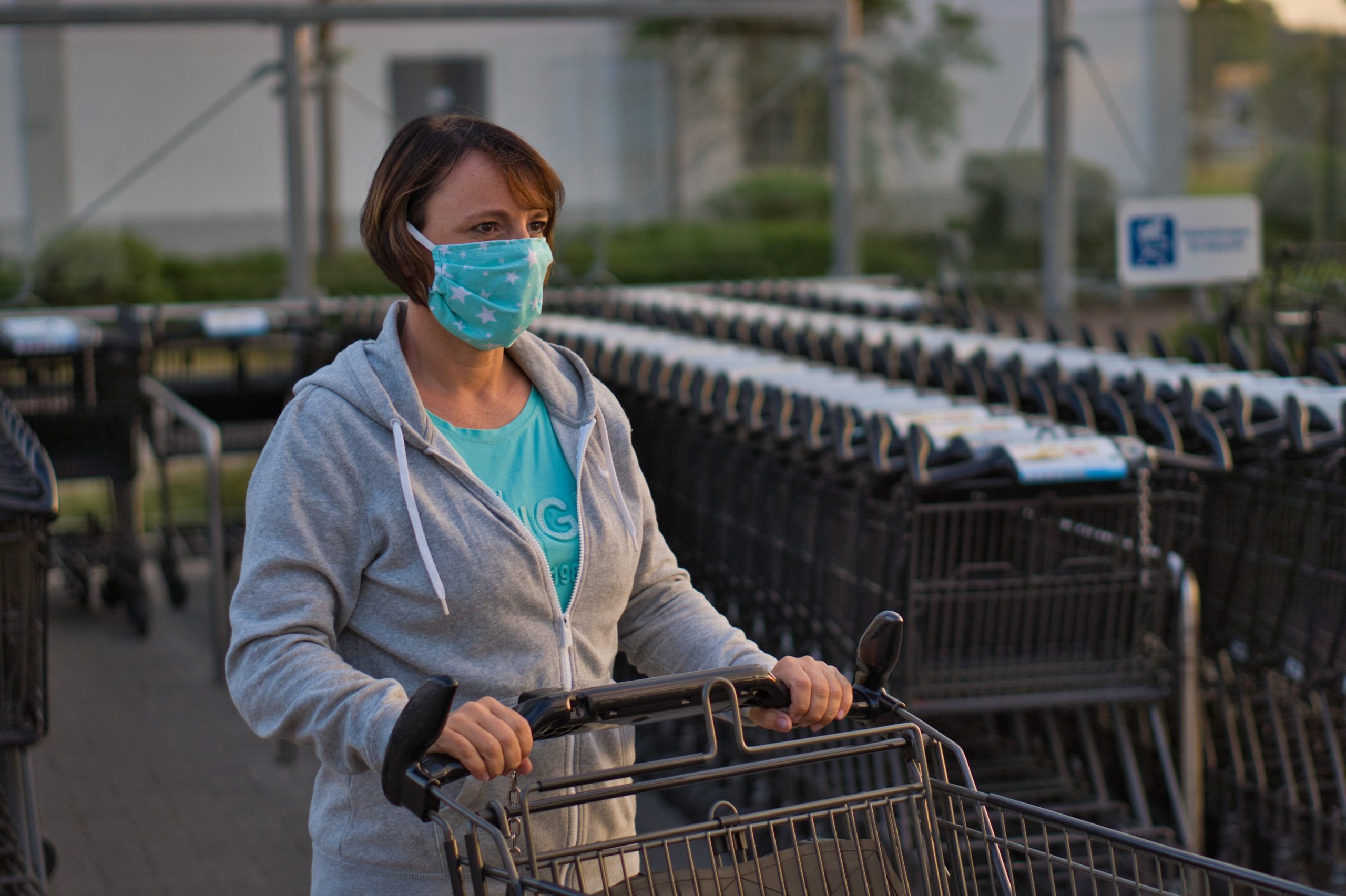COVID-19 has made service sector jobs much more dangerous. But, while the Centers for Disease Control and Prevention (CDC) released guidelines to prevent infections in the workplace, employers were largely left to adopt measures at their own discretion. Scattered reports suggested that these efforts often fell short, especially early in the pandemic and that substantial variation in the adoption of safety practices persisted across states and firms.
Between March of 2020 and May of 2020, The Shift Project surveyed 12,231 service sector workers employed at 107 of the country’s largest retail, food service, grocery, hardware, and delivery and fulfillment firms. The Shift Project then collected an additional 11,651 responses from service sector workers employed at 71 firms between September and November of 2020. These surveys allowed us to peer inside firms and compare across states to describe changes in safety measure adoption as public understanding of the pandemic grew.
We document that employer provision of masks and requirements that employees wear masks were slow to be implemented in the first weeks of the COVID19 pandemic. However, by late May of 2020, employee masking requirements were reported by a large majority of workers employed at the largest food service and retail companies in the United States. Among large employers whose employees we surveyed twice over the course of the Spring of 2020, each one saw increases in the share of workers reporting mask requirements. However, this share varied significantly across sectors, across firms, and even between firms within sectors. In food service and retail, in particular, at some employers, as many as a third of workers still reported that masks were not required of workers. Mask mandates were also imposed unevenly across states, with faster and higher rates of mandate in the Mid-Atlantic and New England states. While employer requirements that employees wear masks became quite widespread by late May of 2020, workers still faced considerable hazards at work as late as November of 2020. Specifically, significant shares of workers reported that customers only sporadically masked and that they were unable to socially distance from other people at work. These hazards were particularly pronounced at food service employers.
Changes in Adoption of Health and Safety Measures Over Time
Early responses to COVID-19 emphasized glove provision and additional cleaning as workers at large service sector firms reported significant increases in both through the month of March. Requirements to wear gloves significantly lagged glove and mask provision and especially mask requirements were rare at large firms through early April.
But, by mid-April and then through May, mask provision by employers rose sharply to nearly 80% of workers and mask requirements rose substantially as well, reaching 60% of workers by mid-April. Figure 1 shows this sharp increase in mask provision and requirements in April, which corresponded to an emerging understanding that non-surgical face coverings prevent infections. By May, respondents reported high levels of mask provision (89%), mask requirements (79%), glove provision (77%), and additional cleaning (70%). Requirements to wear gloves remained low and leveled off at around 37%. For the rest of this brief, we focus on mask-related safety measures as we now understand the importance of airborne transmission as a major source of COVID-19 infections.
Figure 1. Adoption of Infection Reducing Measures Over Time

May Adoption of Masks by Industry
By May, retail and service-sector industries largely converged on relatively high rates of mask provision. There were lower rates of mask requirements and more variation between industries. Restaurant and fast food industries stood out as having both relatively low mask provision and requirement rates.
Figure 2 displays the provision of masks and adoption of mask requirements in May 2020 by industry. With the exception of the restaurant, fast food, and delivery vehicle industries, workers in each industry reported mask provision rates at or above 90%. Mask requirement rates were lower and more varied between industries from a low of 53% for delivery vehicle workers to 95% for coffee shop or cafe workers. Convenience store and gas station workers reported the second lowest rate of mask requirements at 65%.
The low mask requirement rate for warehouse workers coincided with lower rates of customer interaction. Workers who said they never interacted with customers were 13 percentage points less likely to have mask requirements. Many warehouse workers said they never interacted with customers (41%) while a tiny portion of workers in almost every other industry reported no interactions with customers (1 to 4%). However, many fulfillment center workers also said they never interacted with customers (58%), but reported high rates of mask requirements (81%). We did not, however, ask respondents about their level of interactions with co-workers. A low level of customer interactions did not explain low rates of mask requirements for delivery vehicle, convenience store or gas station, fast food, and restaurant workers. Over 80% of workers in each of these industries interacted with customers always or often.
Figure 2. Mask Adoption in May by Industry
Changes in Adoption Over Time by Employer
We surveyed 8,422 workers at 32 of the largest retail and food service firms at two points in time – once early in the COVID-19 pandemic (average survey date was April 1) and once later in the spring of 2020 (average survey date was May 20). Only employers with 30 or more respondents in each wave are shown.
Within each industry, there was more variation in mask provision in the first wave compared to the second wave. Figure 3 shows that by late April and May of 2020, more than 80% of workers at almost every firm reported employer mask provision. Among food service employers, only Waffle House and Papa John’s stood out for having fewer than 80% of their workers report employer mask provision. Of warehouse, fulfillment, and delivery workers, UPS had the smallest share workers reporting mask provision at 73%, despite a larger share of UPS workers reporting mask provision than FedEx and Amazon workers at the first wave.
Figure 3. Masks Available in Wave 1 and 2 by Employer
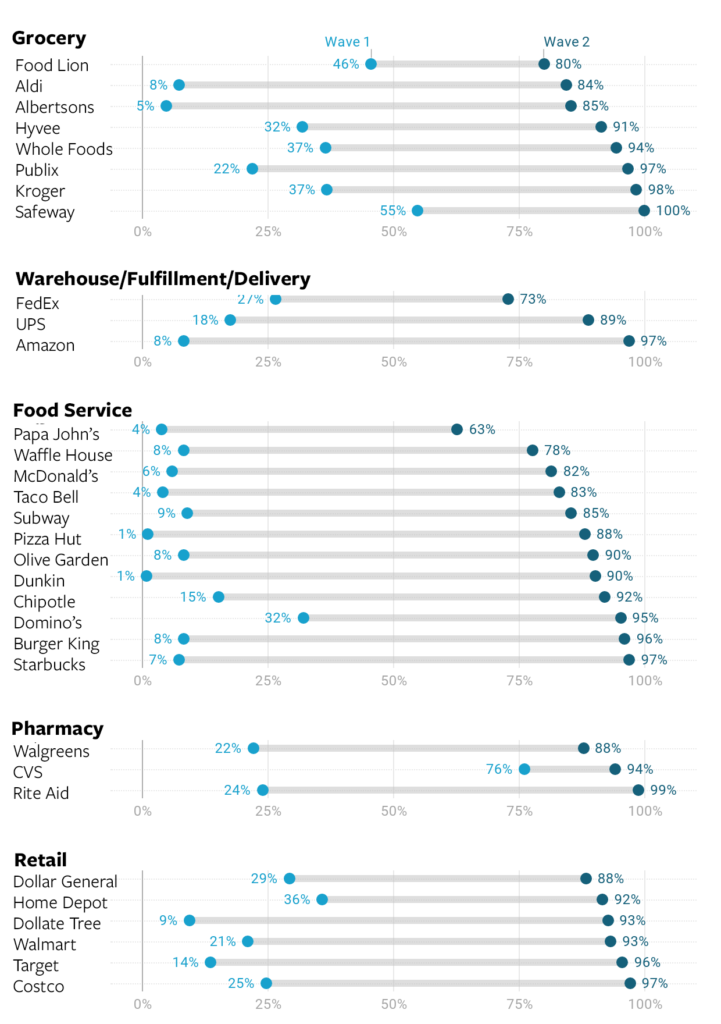
Interactive Visualization of Change in PPE Adoption by Employer
There was a great deal of variation in worker reports of employer mask requirements between employers of the same industry. Figure 4 shows that in each industry, there were employers at which more than 80%, if not above 90%, of workers reported employer mask mandates in late April and May. Some employers, however, appeared to lag behind other employers in their industry. Among grocery employers, a substantially smaller share of workers at Food Lion reported mask requirements, at 51%.
Two of the three employers in the warehouse, fulfillment, and delivery group had low shares of workers reporting mask requirements: about half of workers at FedEx and UPS reported mask requirements. In comparison, Amazon workers reported mask requirements at a rate of 86%.
Workers at four of the twelve food service employers reported rates of mask requirements below 80%: Papa John’s (66%), Waffle House (66%), McDonald’s (72%), and Taco Bell (74%). Starbucks stood out as having a much higher share of workers reporting mask requirements at 95%.
Although a larger share of CVS workers reported employer mask requirements in the first wave than at Walgreens and Rite Aid, workers at all three pharmacy employers reported mask requirements between 80% and 95% in the second wave.
Finally, the retail sector was split into high- and low-share employers. Dollar General, Home Depot, and Dollar Tree workers reported mask requirement rates between 38% and 60%. On the other hand, Walmart, Target, and Costco workers reported mask requirement rates between 87% and 92%.
Figure 4. Mask Requirements in Wave 1 and 2 by Employer
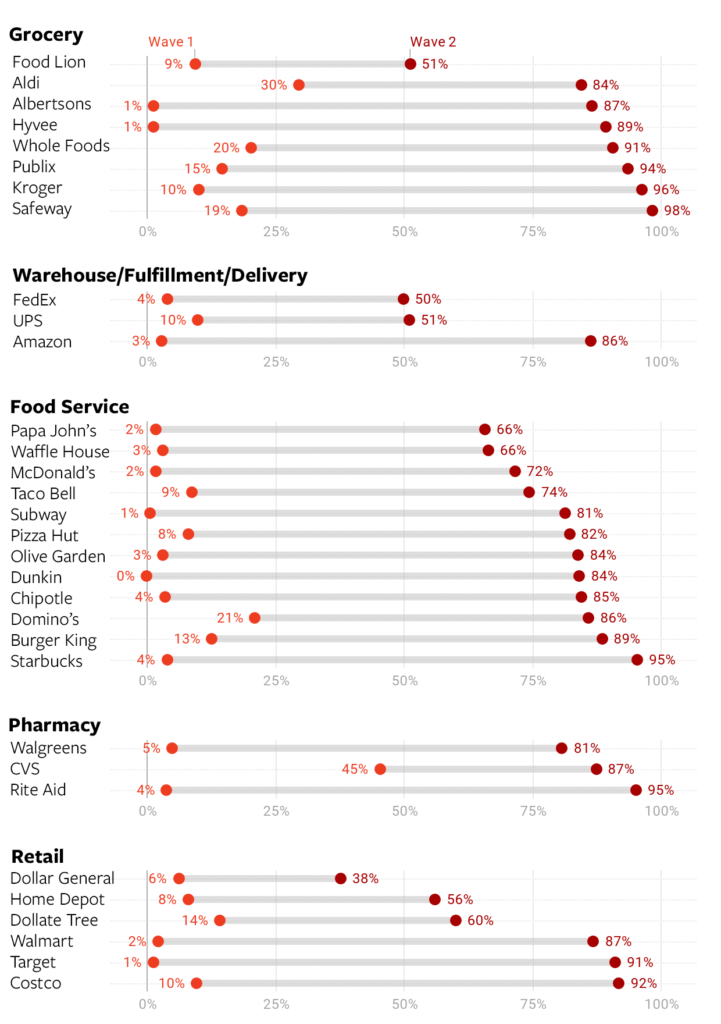
Regional Variation in Employee Mask Requirements
Figure 5 displays the proportion of respondents that reported employee mask requirements by state and month. Only state-months with 50 or more respondents are shown. In March, aggregating to the state-level, in no state did more than 10% of workers report that their firm had a mask requirement. By April, the share of workers reporting that their employer had a mask requirement had increased in most states, but especially in the Mid-Atlantic. By May, in every state more than 50% of employees reported that their employer had a mask requirement. Some states in the Mid-Atlantic, Midwest and South had the highest adoption rates, above 80%. When grouped by division, New England and Mid-Atlantic respondents reported higher rates of employee mask requirements. Overall, the Northeast region of the United States had the highest rates of mask requirements by May.
Figure 5. Employee Mask Requirements by State and Month
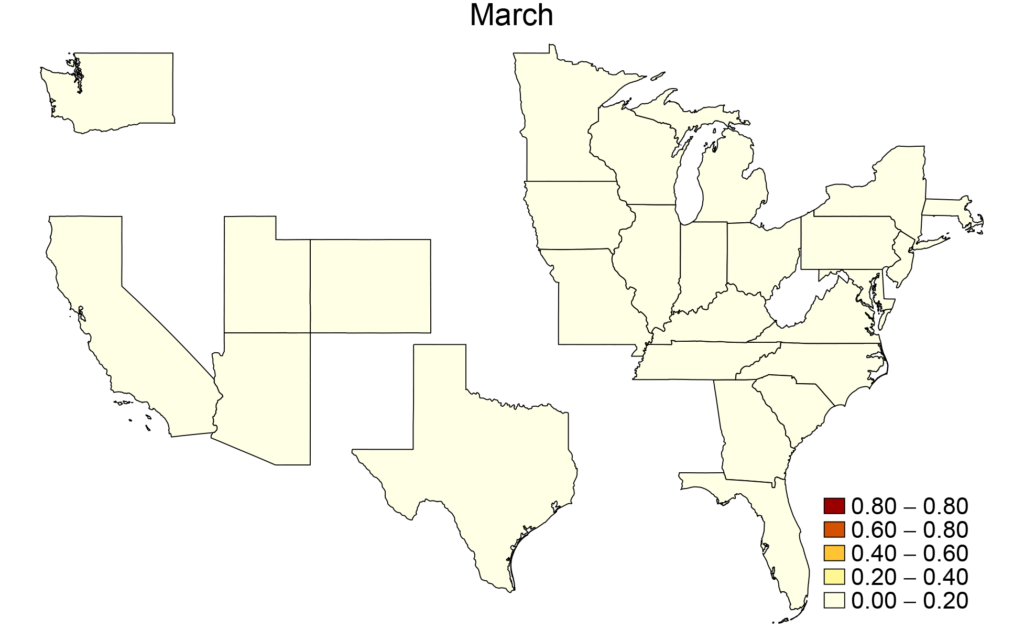
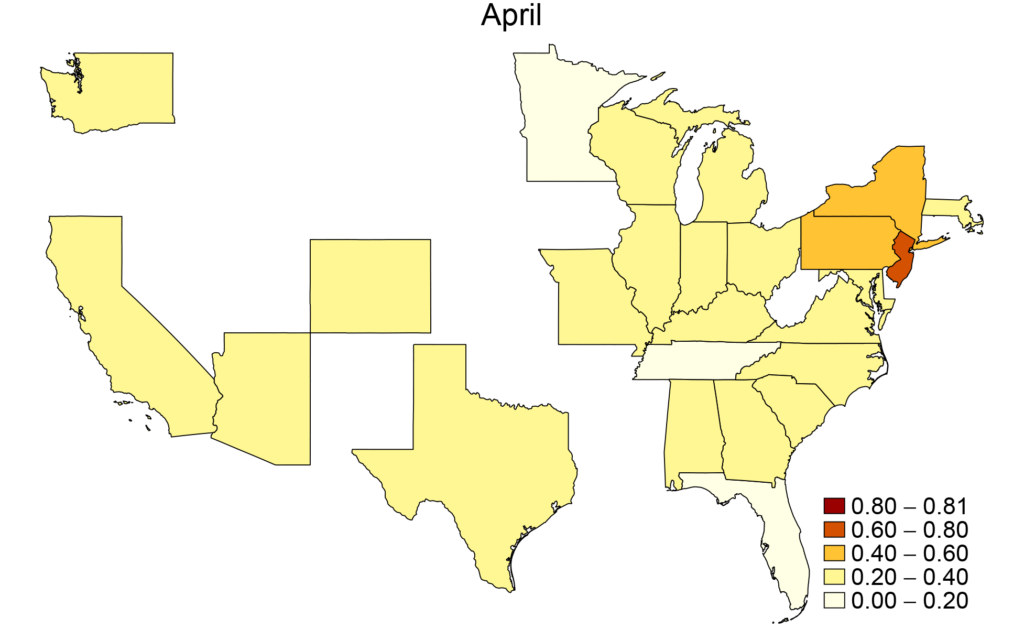
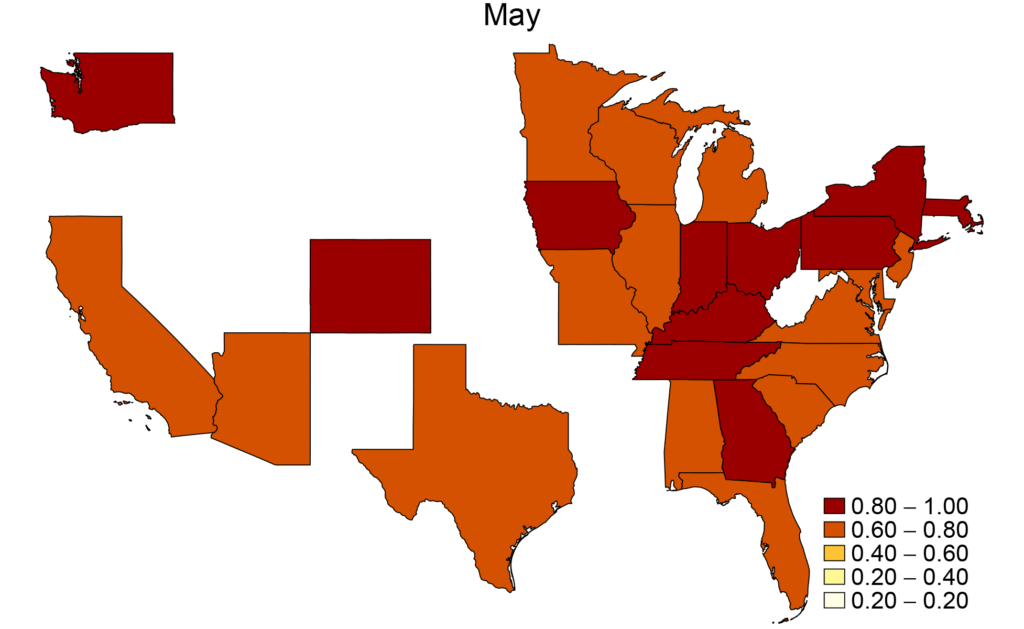
Customer Masking and Social Distancing by Firm
In the Fall of 2020, we surveyed an additional 11,651 workers at 71 large service sector firms. In this survey, we asked workers about how often customers wore masks and how often they were able to practice social distancing at work (maintaining at least 6 feet from other people). Across firms, 72% of workers report that customers always or often wore masks, with 28% reporting that customers did so only sometimes, rarely, or never. Social distancing proved somewhat more challenging, with 59% reporting that they could always or often maintain 6 feet of social distance from other people at work, and 41% reporting that they could do so only sometimes, rarely, or never. Put together, we find that 16% of workers reported that customers only sometimes, rarely, or never work masks and that they could only sometimes, rarely, or never socially distance.
However, these averages disguise significant differences across employers. Figure 6a shows the share of workers by employer who reported that customers at their workplace only sometimes, rarely, or never wore masks. The lack of customer masking is highest for food service workers, with more than 40% of workers at many of the food-service firms reporting a lack of customer masking. Figure 6b plots the share of workers by employer who reported that they were only sometimes, rarely, or never able to socially distance from other people while at work. Though not without exception, this hazard is most common at food service employers as well. Putting these two practices together, in Figure 6c we see that as much of a third of workers at food service employers, including Sonic, Waffle House, Chick-Fil-A, Wendy’s, Arby’s, and Taco Bell, report that customers have low rates of masking and that they have limited ability to socially distance.
Figure 6a. Customer Masking by Employer
Figure 6b. Employee Social Distancing by Employer
Figure 6c. Customer Masking and Employee Social Distancing by Employer
Workers at these same firms provided detailed accounts of the workplace conditions that all too often made them feel unsafe. Time and again, respondents to our survey emphasized insufficient mask wearing among customers and the difficulties they faced in maintaining social distancing.
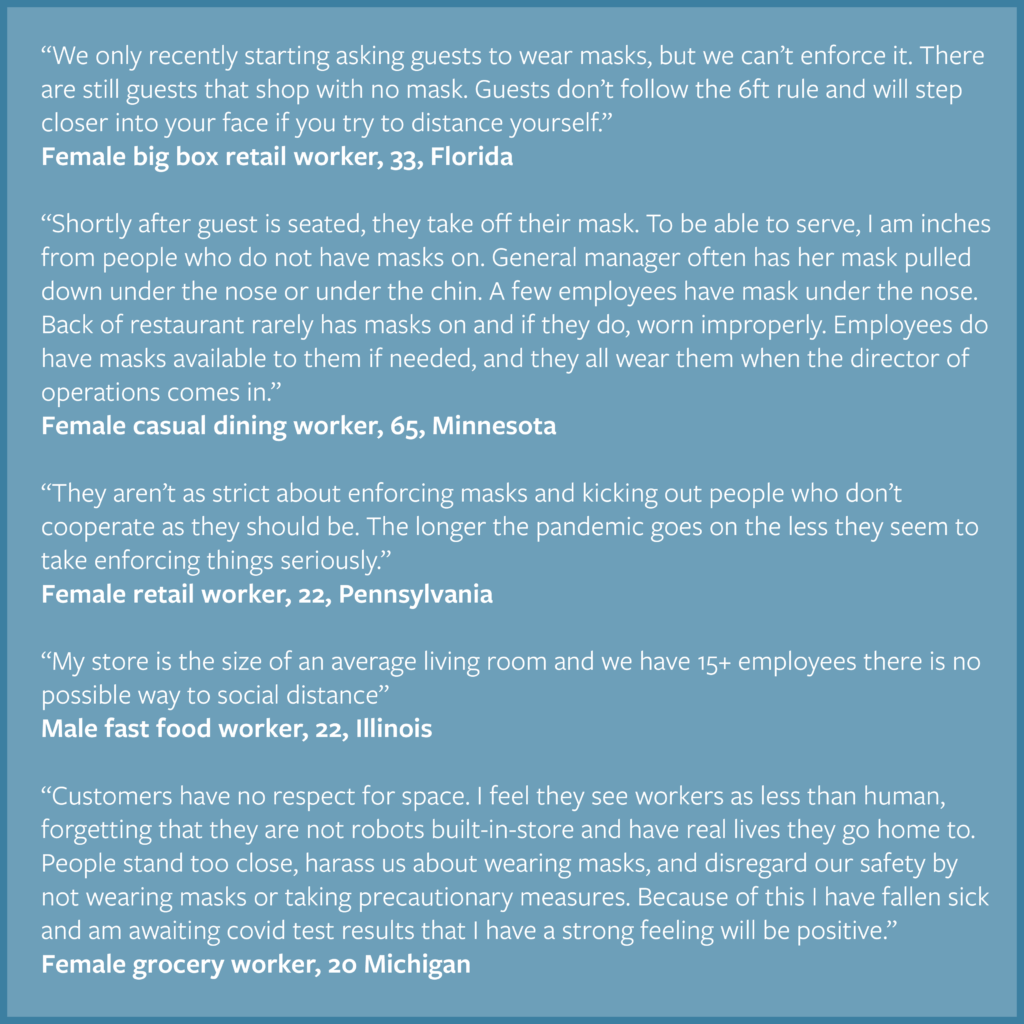
Conclusion
Employer provision of masks and requirements that employees wear masks were slow to be implemented in the first weeks of the COVID19 pandemic. However, by late May of 2020, employee masking requirements were reported by large shares of workers employed at the largest food service and retail companies in the United States. Among large employers whose employees we surveyed twice over the course of the Spring of 2020, each one saw increases in the share of workers reporting mask requirements. However, this share varied significantly across sectors, across firms, and even between firms within sectors. In food service and retail, in particular, at some employers, as much as a third of workers still reported that masks were not required of workers. Mask mandates were also communicated unevenly across states, with faster and higher rates of mandate in the Mid-Atlantic and New England states in particular. While employer requirements that employees wear masks became quite widespread by late May of 2020, workers still faced considerable hazards at work as late as November of 2020. Significant shares of workers reported that customers only sporadically masked and that they were unable to socially distance from other people at work. These hazards were particularly pronounced at food service employers.
Acknowledgements
The authors gratefully acknowledge the work of Rebecca Wolfe, Connor Williams, Eli Munn, and Megan Collins in the preparation of this report.
The Shift Project gratefully acknowledges funding from the Bill & Melinda Gates Foundation, the Robert Wood Johnson Foundation, and the W.T. Grant Foundation. The findings and conclusions contained within are those of the authors and do not necessarily reflect positions or policies of the foundations.
